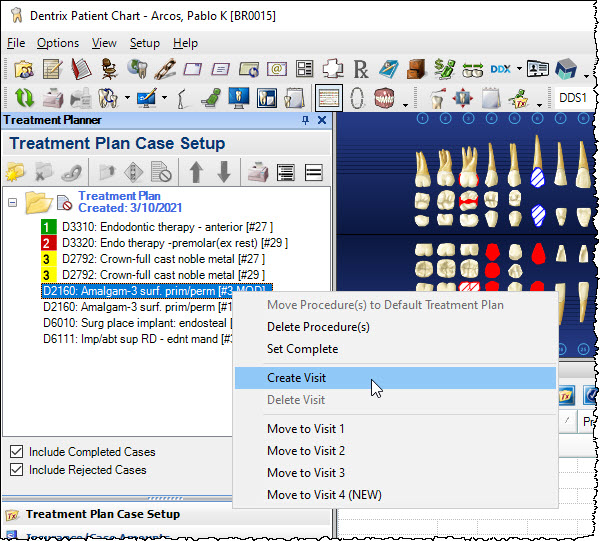A Dentist's Guide to Dentrix Case Acceptance Tools
- Maxillo Team
- Oct 30
- 6 min read
For most dental practices, there is a painful gap between the total value of treatment diagnosed in a day and the value of treatment that actually gets scheduled. This is the case acceptance gap. According to research cited by industry analysts, case acceptance rates for two-thirds of U.S. dental practices fall between 20% and 50%. This is a long way from the common industry target of 90% [1].
This gap represents more than lost revenue. It represents patients who are not receiving the care they need, which can lead to more complex and costly health problems down the road.
As a practice owner or manager, you know that closing this gap is a high priority. But the solution may not be a new sales script or a high-pressure closing technique. The solution is a reliable system. For the thousands of practices running on Dentrix, the foundation of this system is already built into the software. You just have to use it.
Many offices use Dentrix as a digital file cabinet and scheduling book, but they miss the powerful, integrated features designed specifically to help patients understand and accept treatment. This article explains the core Dentrix case acceptance tools, how to use them effectively, and how to plug the final, critical leak in your schedule that Dentrix alone cannot.
The Core: The Dentrix Treatment Planner
Case acceptance does not begin at the front desk. It begins in the operatory during the case presentation. The single most powerful tool in your arsenal is the Dentrix Treatment Planner. Its purpose is to transform a clinical diagnosis into a clear, professional, and easy-to-understand presentation for the patient.
If your team is still handwriting estimates or printing confusing ledgers, you are creating friction. The Treatment Planner removes this friction in three specific ways.
1. Building and Presenting Multiple Options
Patients who feel railroaded into a single, expensive treatment plan will often use "I need to think about it" as a polite way to say "no." The Treatment Planner allows you to create, link, and present multiple treatment cases.
You can build the "ideal" treatment (e.g., implant, build-up, and crown) as Case 1. Then, you can build an "alternative" option (e.g., a fixed bridge) as Case 2. By linking these cases, you empower the patient. You shift the conversation from a "yes/no" decision to a "which is best for me" decision.
This approach aligns with well-established communication psychology. When you present options, you are no longer a salesperson. You are an educator and a partner in their health. You can use the visual aids within the Treatment Planner, such as intraoral photos or X-rays, to show why the treatment is necessary, connecting the clinical need to the financial plan.
2. Providing Immediate Financial Clarity
The number one reason patients reject treatment is ambiguity about cost [1]. The Treatment Planner integrates directly with the patient's insurance and fee schedules. This allows you to show the patient their estimated co-payment, not just the total production value.
When a patient sees "Total Fee: $4,500," they may experience sticker shock. When they see "Total Fee: $4,500; Your Estimated Insurance Benefit: $1,500; Your Estimated Portion: $3,000," the conversation changes. It becomes manageable.
[TIP: Present dental financing options to increase case acceptance.]
The tool also allows you to set up and apply in-office financing or third-party payment options, breaking that $3,000 portion into manageable monthly payments. Clarity is the antidote to fear, and financial clarity is the key to case acceptance.
3. Tracking the "Yes" with Case Statuses
This is the most underutilized feature. A plan is not "accepted" just because the patient nodded in the chair. In Dentrix, treatment must have a formal status. The default statuses are:
Created: The plan exists but has not been presented.
Proposed: You have presented the plan to the patient.
Accepted: The patient has verbally or in writing agreed to the plan.
Rejected: The patient has declined the plan.
Why is this so important? Because it creates accountability. If you do not formally update the case status to "Accepted" or "Rejected," that plan falls into a digital black hole. Your front office team has no way to run a report of "Proposed, Unscheduled Treatment."
By enforcing a simple workflow, you create a powerful follow-up list. At the end of every week, your office manager can run a report of all cases still in "Proposed" status. These are your warmest leads. They already have a diagnosis and a plan. They just need a follow-up call, which brings us to the next set of tools.
Automating Follow-Up with Dentrix Case Acceptance Tools
A "yes" in the operatory is useless if the patient never schedules the appointment. The second arm of the Dentrix system is its patient communication suite, primarily Dentrix Patient Engage. This is what bridges the gap between the clinical presentation and a confirmed appointment on the schedule.
Effective communication is proven to build trust and increase a patient's adherence to treatment [2]. Patient Engage automates this trust-building.
First, it automates the obvious: appointment reminders. A patient who accepts a case but no-shows the appointment is a net loss. Automated text and email reminders are the first line of defense. They confirm the patient's commitment and solidify the appointment in their personal calendar.
Second, it can automate treatment plan follow-up. For a patient who left with a "Proposed" plan, you can use the system to send them a secure email with a link to their treatment plan. This allows them to review the options they discussed with the doctor in the comfort of their own home, away from the pressure of the clinic.
Finally, these tools handle pre-appointment instructions. Sending a simple message like, "We look forward to seeing you tomorrow at 10:00 AM for your crown prep. Remember not to eat or drink after midnight," reinforces the importance of the appointment and reduces the chance of a last-minute cancellation.
These native tools are excellent for managing the patient journey from diagnosis to the day of the appointment. But they have one significant blind spot. They cannot react in real time when a patient breaks the sequence.
The Gap: Filling Cancellations and Stopping No-Shows
You have done everything right. The doctor used the Treatment Planner. The patient reviewed the three options and chose the best one. Your team marked the case "Accepted." The patient confirmed their appointment twice via Patient Engage.
Then, 30 minutes before the $4,500 procedure, they call to cancel.
Your practice just lost a huge block of production. That empty chair is a revenue black hole. A single no-show appointment can cost a practice $200 or more on average, and these losses quickly add up to billions across the healthcare industry [3].
This is the problem Dentrix was not built to solve. Dentrix is a system of record. It is not a proactive, artificially intelligent system. It will record the cancellation, but it will not fill it.
This is where modern AI platforms come in. These solutions are designed to integrate directly with your Dentrix database and act as an intelligent assistant for your front office. They attack this problem in two ways:
1. Proactively Reducing No-Shows
Instead of just sending generic reminders to everyone, AI platforms use predictive analytics. The software scans your schedule and identifies patients who are at a high risk of no-showing. This "at-risk" score can be based on their past appointment history, the time of day, and other factors.
Your team can then target these high-risk patients for extra attention, such as a personal phone call, while letting the automation handle the "low-risk" confirmations. This focuses your team's valuable time where it will have the greatest financial impact.
2. Actively Filling Cancellations
This is the true game-changer. When that $4,500 procedure is canceled, the AI immediately and automatically goes to work.
It recognizes the open 2-hour slot in the Dentrix schedule.
It scans your "ASAP List" or "Waitlist" for patients who are waiting for an opening.
It also scans all "Proposed" or "Accepted" but unscheduled treatment plans in your system.
It sends an automated, personalized text message to a targeted list of those patients. For example: "Hi, this is Dr. Smith's office. We just had a last-minute opening at 2:00 PM today. Would you like to take it? Reply YES to book."
The first patient to reply "YES" automatically has their appointment written back into the Dentrix schedule, and the system stops offering the slot.
This all happens in seconds, before your front office team has even finished updating the schedule. The empty, high-value slot is filled, your production is saved, and a grateful patient gets their treatment sooner.
The Complete System: Dentrix + AI
Your practice's success hinges on a complete system. The Dentrix case acceptance tools provide the essential foundation. The Treatment Planner creates clarity and empowers patients to say yes. The case status feature creates accountability. Patient Engage automates the communication to get that patient to the appointment.
But to protect that hard-earned production, you need the final piece. You need an intelligent layer that works 24/7 to reduce no-shows and, most importantly, fills the gaps that inevitably appear. By combining the robust record-keeping of Dentrix with the proactive intelligence of AI, you finally close the loop, ensuring the care you diagnose is the care you deliver.
Sources
[1] TrueLark. (2023). Dental Case Acceptance: How to Increase Patient Acceptance Rates for DSOs. https://truelark.com/how-ai-boosts-dso-dental-case-acceptance-rates/
[2] Wong, F. M. F., et al. (2025). An Overview of Dentist–Patient Communication in Quality Dental Care. National Institutes of Health (PMC). https://pmc.ncbi.nlm.nih.gov/articles/PMC11763373/
[3] Curogram. (2025). How Much Each Year Do No Shows Cost the U.S. Healthcare System?. https://curogram.com/blog/how-much-each-year-do-no-shows-cost-the-u.s-healthcare-system






Comments